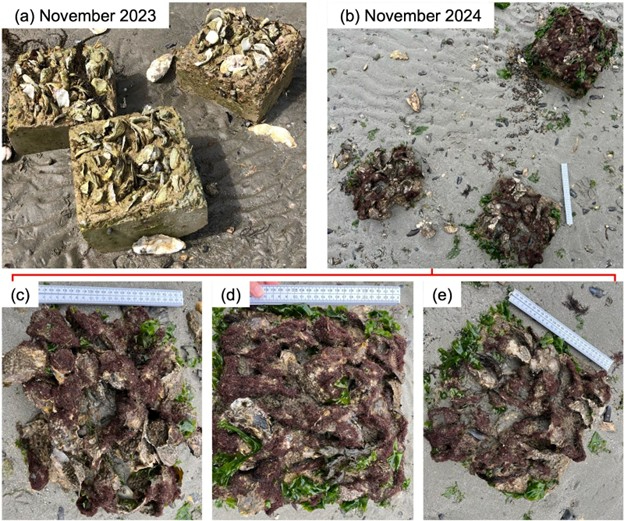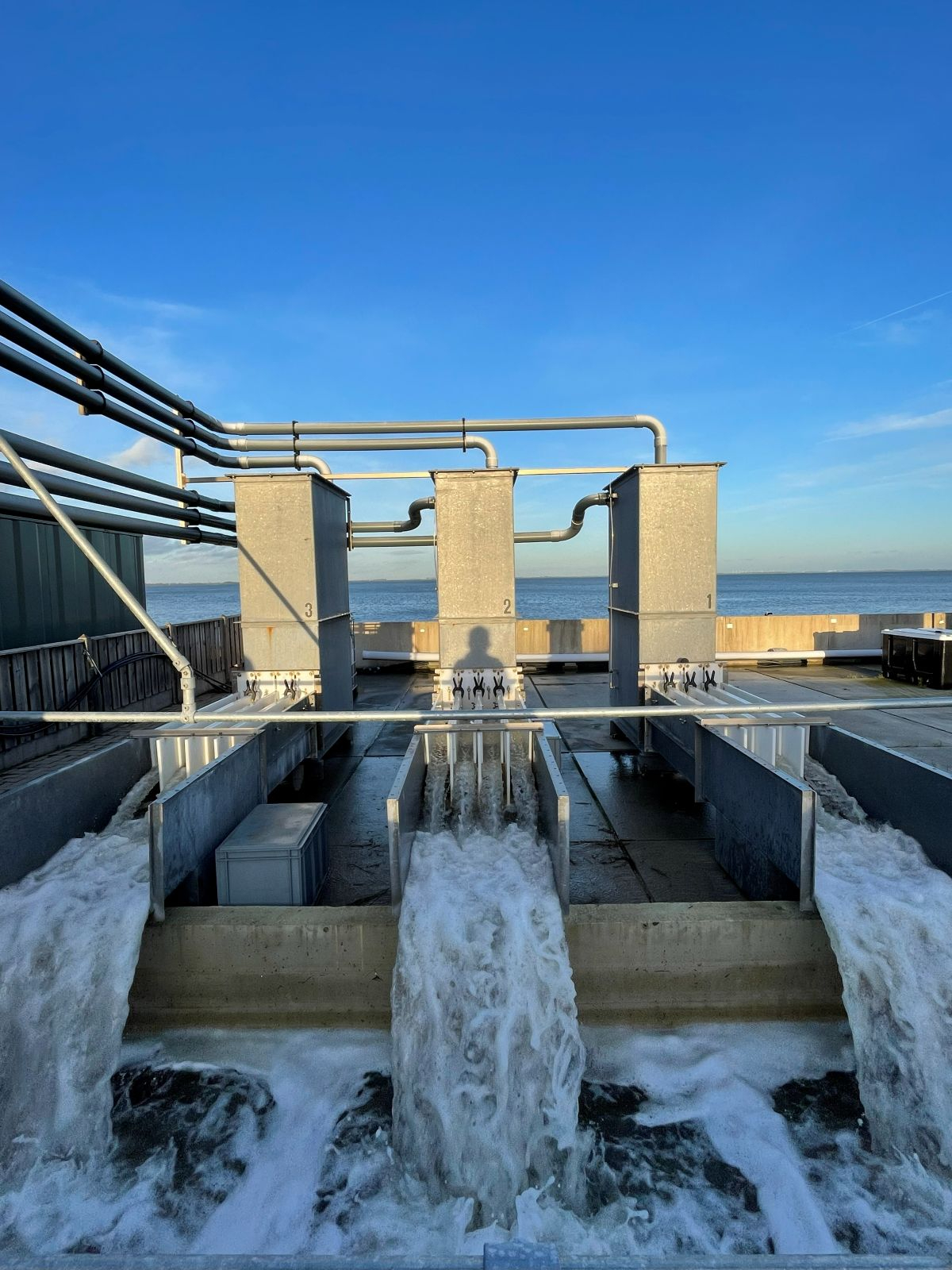Biobased concrete substitute can give coastal restoration a natural boost
[Dutch text: see below]
Using different variants of Xiriton NIOZ researchers set to work at the research institute in Yerseke. Xiriton is easy to make with chopped dried grass, volcanic pozzolan, slaked lime, shells, sand and seawater. But is it also suitable for restoring tidal areas such as salt marshes and shellfish reefs where necessary?
Covered with life
The idea is that temporary structures in tidal areas provide a place where mussels and oysters can settle in areas where they have disappeared or declined significantly. The researchers placed blocks of Xiriton on the mudflat in Yerseke, where they were exposed to the tides twice a day. ‘After a year, every block was around 70 per cent covered with life such as oysters, mussels and algae,’ says PhD candidate Victoria Mason. ‘This indicates that Xiriton blocks are not only cheap, sustainable and practical to manufacture on a large scale, but also suitable for use in enhancing settlement and potentially restoring biodiversity. By adjusting the lifetime of the material, it can also break down naturally into harmless substances once a reef can sustain itself, instead of remaining permanently in the ecosystem.’
Cordgrass or bamboo
The researchers used cordgrass (Spartina anglica), which is widely available locally, and Elephant grass (Miscanthus giganteus), to make Xiriton. Other types of grass, such as reed or bamboo, could also be used, as long as they are harvested sustainably. Depending on the drying time of the material and the amount of binder in the mix, it becomes stronger. Mason: ‘After five weeks of drying, it was at its hardest.’ The research showed that the acidity of the material is favourable. Mason: ‘With a pH value of 8 to 9, it is much more neutral than standard concrete, which is more alkaline. Concrete has a pH of around 13, which can be unfavourable for organisms that need to settle on it.’
Coffie cup shaped objects
The researchers found that after 63 days of heavy flow, Xiriton is as strong as concrete alternatives such as those made with Roman cement. In the so-called Fast Flow Fume (photo), for example, they unleashed a strong current on pieces of Xiriton that had been made using coffee cups as moulds, in an enhanced erosion experiment to test the adjustability of the material lifetime. That was the task of Jente van Leeuwe, then a master's student in Earth & Environment at WUR, now a PhD student at NIOZ. ‘We used those coffee cups to place the material in the flow instead of having the flow go over the structure, like with tiles.’
Flexible, temporary and cheap
Mason: 'For the purpose of intertidal restoration, we need materials that are not environmentally harmful in the short or long term. They must be flexible in terms of what shapes we can build, and temporary, so they don't require expensive removal or leave harmful products in the environment. As well as that, they need to be inexpensive enough to be upscaled to larger projects and different areas.'
Follow-up study
The researchers want to conduct a follow-up study to determine whether Xiriton is also suitable for large, wave-breaking structures. Dependent on the composition, the lifetime of these semi-permanent structures could be altered – to be long enough to serve as temporary scaffolding for natural reef formation.
Almost everything you can do with bricks
The developer of Xiriton is Swiss Frank Bucher, who lives in Stiens, Friesland. Back in 2009, he won an award for the concept, which he says can be used to build anything you can build with bricks. ‘All buildings up to three stories high, for example. But you don't have to bake it and you don't need clean drinking water. You can make it with ditch or sea water.” To his regret, the material has not yet been used in the construction industry. ‘The combination with wood enables new construction concepts, including for hydraulic engineering. Wood reinforces Xiriton, and Xiriton protects the wood.’ In the world of coastal restoration, people are open to it, Bucher notices. Xiriton is also the subject of research at Van Hall Larenstein University of Applied Sciences.
Mason is nearing the end of her PhD research. ‘I have enjoyed working with Xiriton as a more practical, applied side to my research. We were able to explore concepts of ecosystem restoration with a view to offering a realistic, non-harmful and globally upscalable option to placing materials into ecosystems, where intervention is required.’
Not a luxury, but a necessity
Senior researcher Jim van Belzen, also involved in the publication, places the research in a broader perspective. 'The built world now weighs more than all the biomass on Earth. If we really want to reduce our footprint, we need to radically rethink the way we build. New biobased concepts – where nature, circularity and regeneration are central – are not a luxury, but a necessity. The technology is still in its infancy, but biodiversity will not wait.'
According to Van Belzen, Xiriton offers prospects for nature-inclusive applications in coastal protection and ecosystem restoration. The material combines the strength and malleability of concrete with a much smaller ecological footprint and could potentially be used for breakwaters, seawalls or artificial reefs that enhance natural processes. ‘The future of water safety? It could well be greener than stone and concrete.

Biobased betonvervanger kan kustherstel een natuurlijke impuls geven
Een innovatief alternatief voor beton blijkt veelbelovend voor gebruik bij restauratie van kusten. Het materiaal Xiriton, gemaakt met lokale grassen en zeewater, legt CO2 vast in plaats van het uit te stoten zoals gangbaar beton. NIOZ-onderzoekers testten het materiaal met succes op geschiktheid als substraat voor bijvoorbeeld schelpenbanken of herstel van kwelders. Ze publiceerden hun werk in het tijdschrift Frontiers in Marine Science.
Met verschillende varianten van Xiriton gingen NIOZ-onderzoekers aan de slag bij het onderzoeksinstituut in Yerseke. Xiriton is gemakkelijk te maken met snippers gedroogd gras, gebluste kalk, vulkanische puzzolaan, schelpen, zand en zeewater. Maar is het ook geschikt om getijdengebieden zoals zoutmoerassen en schelpdierriffen te restaureren waar dat nodig is?
Bedekt met leven
Het idee is dat tijdelijke structuren in getijdegebieden een plek vormen waarop mossels en oesters zich kunnen vestigen op plekken waar ze zijn verdwenen of sterk afgenomen. De onderzoekers legden Xiriton-blokken op het slik in Yerseke, waar ze tweemaal daags werden blootgesteld aan de getijden. ‘Na een jaar was elk blok voor zo’n 70 procent bedekt met leven als oesters, mossels en algen’, aldus promovenda Victoria Mason. ‘Dat wijst erop dat Xiriton-blokken niet alleen goedkoop, duurzaam en praktisch zijn om op grote schaal te maken, maar ook geschikt om de vestiging van soorten te stimuleren en de biodiversiteit te herstellen. Door de levensduur van het materiaal naar wens aan te passen, breekt het vanzelf af tot onschadelijke stoffen als een rif zichzelf in stand kan houden.’
Slijkgras of bamboe
De onderzoekers gebruikten lokaal slijkgras (Spartina anglica) en olifantsgras (Miscanthus giganteus) om Xiriton te maken. Het kan ook met andere soorten C4-gras, zoals riet of bamboe zolang het duurzaam wordt verbouwd. Afhankelijk van de droogtijd die het materiaal krijgt en de hoeveelheid bindmiddel in de mix, wordt het sterker. Mason: ‘Na vijf weken droogtijd was het het hardst.’ In het onderzoek bleek de zuurgraad van het materiaal gunstig. ‘Met een pH-waarde van 8 tot 9 is het veel neutraler dan het meer basische standaard-beton. Dat heeft een pH van ongeveer 13, wat ongunstig kan zijn voor organismen die zich erop moeten vestigen.’
De vorm van koffiebekers
De onderzoekers stelden vast dat Xiriton na 63 dagen bij flinke stroming even sterk is als Romeins beton. In de zogeheten Fast Flow Fume (foto) lieten ze een krachtige stroming los op stukken Xiriton die gemaakt waren met koffiebekers als mal. Deze erosieproef om de aanpasbaarheid van de levensduur van het materiaal te testen was de taak van Jente van Leeuwe, toen nog master-student Earth & Environment bij WUR, inmiddels promovendus bij het NIOZ. ‘Die koffiebekers gebruikten we om het materiaal vol in de stroming te zetten. Bij tegels gaat de stroming er alleen eroverheen.’
Flexibel, tijdelijk en goedkoop
Mason: ‘Voor het herstel van het getijdengebied hebben we materialen nodig die onschadelijk zijn voor het milieu. Ze moeten flexibel zijn wat betreft de vormen die we kunnen bouwen en tijdelijk, zodat ze niet tegen hoge kosten verwijderd hoeven te worden of schadelijke producten achterlaten in de omgeving. Ook moeten ze goedkoop genoeg zijn om opgeschaald te worden naar grotere projecten en verschillende gebieden.’
Vervolgstudie
De onderzoekers willen met een vervolgstudie vaststellen of Xiriton ook geschikt is voor grote, golfbrekende constructies. Door de samenstelling aan te passen kan de levensduur van de semipermanente structuren langer of korter zijn – lang genoeg om als tijdelijke steiger te dienen voor natuurlijke rifvorming.
Bijna alles wat met baksteen kan
De ontwikkelaar van Xiriton is de Zwitser Frank Bucher, die woont in het Friese Stiens. Al in 2009 won hij een prijs met het concept, waarmee je volgens hem bijna alles kunt bouwen wat je ook met baksteen kunt bouwen. ‘Alle gebouwen tot drie verdiepingen hoog bijvoorbeeld. Maar je hoeft het niet te bakken en er is geen schoon drinkwater voor nodig. Je kunt het met sloot- of zeewater maken.’ Tot zijn spijt wordt het materiaal tot nu toe niet gebruikt in de bouwwereld. ‘De combinatie met hout maakt nieuwe bouw-concepten mogelijk, ook voor de waterbouw. Hout versterkt Xiriton en Xiriton beschermt het hout.’ In de wereld van kustrestauratie staan ze er wel voor open, merkt Bucher. Ook bij Hogeschool Van Hall Larenstein is Xiriton onderwerp van onderzoek.
Realistische en onschadelijke optie
Mason nadert het eind van haar promotieonderzoek. ‘Ik vond het leuk om met Xiriton te werken als een praktische, toegepaste kant van mijn onderzoek,’ zegt ze. ‘We konden concepten voor ecosysteemherstel onderzoeken met het oog op het bieden van een realistische, onschadelijke en wereldwijd opschaalbare optie voor het plaatsen van materialen in ecosystemen, waar dat nodig is.’
Geen luxe, maar noodzaak
Senior-onderzoeker Jim van Belzen, ook betrokken bij de publicatie, plaatst het onderzoek in een breder perspectief. ‘De gebouwde wereld weegt inmiddels meer dan alle biomassa op aarde. Als we onze voetafdruk écht willen verkleinen, moeten we de manier waarop we bouwen radicaal herzien. Nieuwe biobased concepten – waar natuur, circulariteit en regeneratie centraal staan – zijn geen luxe, maar noodzaak. De technologie staat nog in de kinderschoenen, maar biodiversiteit wacht niet.’
Xiriton biedt volgens Van Belzen perspectief voor natuurinclusieve toepassingen in kustbescherming en ecosysteemherstel. Het materiaal combineert de stevigheid en vormbaarheid van beton met een veel kleinere ecologische voetafdruk, en kan mogelijk worden ingezet voor golfbrekers, oeverconstructies of kunstmatige riffen die natuurlijke processen versterken. ‘De toekomst van waterveiligheid? Die zou weleens groener kunnen zijn dan steen en beton.’
